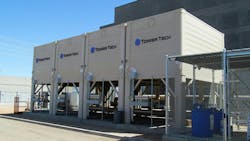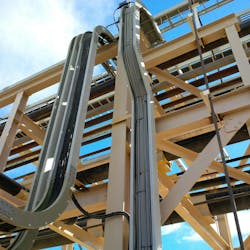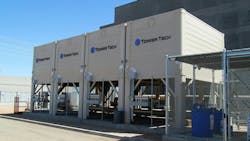“AI this” and “AI that.” So much talk about AI! No matter how over-discussed it may seem, there’s no denying that AI is transforming the data center market. Estimates currently project a 12-15% growth for the data center market by 2030, with new builds accounting for over 50% of this growth. Though less impactful now, long-term limits on market growth include power and water use as well as supply chain constraints.
Integrating alternative materials into the data center supply chain is one way to ease these constraints during data center construction and operation. Composites, specifically fiberglass or FRP (Fiber Reinforced Polymer), have seen increased popularity over the past dozen years, but they are still mostly niche-use in the data center market. Here’s why they shouldn’t be.
How FRP Benefits the Data Center Ecosystem
Data centers are more than just servers. This core infrastructure is supported by a power infrastructure, cooling, security and monitoring, fire suppression and cabling. FRP’s benefits aren’t just to the core of data centers but also to these ancillary systems.
Moisture and heat are the villains of any data center story. Water-based cooling is still very common in data centers, which can introduce humidity, even if leaks are completely mitigated. Any moisture can create a hot, humid ambient environment in a data center, which can contribute to rusting and corrosion and to slippery surfaces for metal—not to mention possible shorts.
FRP is inherently corrosion-resistant, even when constantly exposed to humidity, and it can be made into non-skid surfaces, like custom, walkable covers for floor-level ladder tray and floor-level wireway. These performance qualities can significantly cut down on required maintenance as well.
Metal’s high conductivity and heat transfer are also major concerns. Data center cabling produces a lot of heat when working, and metal support structures will heat right alongside the cables. This directly fights the core directive of data center environmental controls: cool things down. Cooling equipment will have to work harder and use more resources just to break even. Heat conductivity can also increase fire risks. Fire risks increase during new builds that rely on metal infrastructure, since cutting and hot work can produce sparks and heat.
Composites are non-conductive and fire-resistant, have no electromagnetic interference and have low heat transfer. They also require no hot work for installation and only produce no sparks when cut. FRP can be made into nearly any profile or shape and can be engineered to meet many performance specifications, allowing FRP to replace traditionally metal pieces of a data center. This can be especially helpful for hyperscalers looking to minimize their carbon footprint, as steel and concrete significantly contribute to data center environmental footprints.
Where Can FRP Be Used in a Data Center?
The most appropriate uses of composites in data centers will be in structural roles. These aren’t mere plastic pieces helping to direct cables; they have the strength and resilience to replace metallic alternatives in some parts of the data center. Let’s look at where FRP can be integrated into a data center and the biggest benefit over metal in that location.
Ladder trays are often hung from the ceiling of a data center by a trapeze support. Stainless steel ladders are extremely heavy, complicating the secure hanging process. Much lighter aluminum solves the weight issue but not the issue of conductivity and heat transfer. FRP ladder tray can address the weight problem while overcoming metal’s conductivity. The same is true for instrumentation trays and switchracks, which can be made in a slotted or solid bottom to replace metal baskets. Similarly, FRP conduit provides these benefits plus impact-resistant protection for mission-critical cables.
Strut framing can be used to provide lighter-weight structure and support, eliminating some of the weight and footprint of concrete and steel. These structural FRP pieces are also compatible with metal components like metallic spring nuts, without the risks common to mixing metals, though FRP can also be made into fixtures like clips. FRP strut can also be used as cable tray supports and flooring supports, keeping cool air flowing beneath the floor surface.
Insulated and single-skin wall and ceiling panels made from FRP can deliver similar performance properties as metal, including FM approval for fire resitance, in some cases—with the added benefits of corrosion resistance and a much lighter weight.
Composites can be made into walkable, non-skid surfaces and grating, even for not traditionally walkable applications (such as covers for on-ground cable tray). The nonskid surface is part of the product, rather than an add-on, and grating can allow for better ventilation of the space.
Composite cooling towers can provide critical environmental support for data centers. Modular, composite cooling towers are more compact and maximize available footprint. They are also significantly lighter than metal towers and arrive at sites pre-built, reducing emissions, time and labor. One popular design also uses up to ten smaller fans in lieu of the one to three large fans, which increases redundancy to maximize uptime if a fan goes down. This design is also available in a closed-circuit model, which is compatible with heat exchangers.
Why would a data center engineer choose these FRP parts, which weren’t made specifically for data center use, when dedicated products in other materials exist? In truth, many parts that perform a specific duty were designed specifically for that task or industry: products like strut, C-channel and duct are all products used in myriad ways across many industries. The design flexibility and performance characteristics of FRP composites allow the material to be shaped into nearly anything to be applied to meet specifications of so many structural applications.
In Short: Expand Material Choice to Meet Market Expansion
The data center market is growing so fast that designers will need to be nimble and creative to meet timelines, carbon footprints, physical/site limitations and more. Composite FRP has a long history of reliable structural performance and is ready to help the data center market meet its astounding 2030 projections head-on.
About the Author
Roy Silvas
Roy Silvas is business development director for Creative Composites Group. He holds an electrical engineering degree from Texas Tech University and has over 20 years of experience in building construction, cable management, infrastructure, and process operations.


